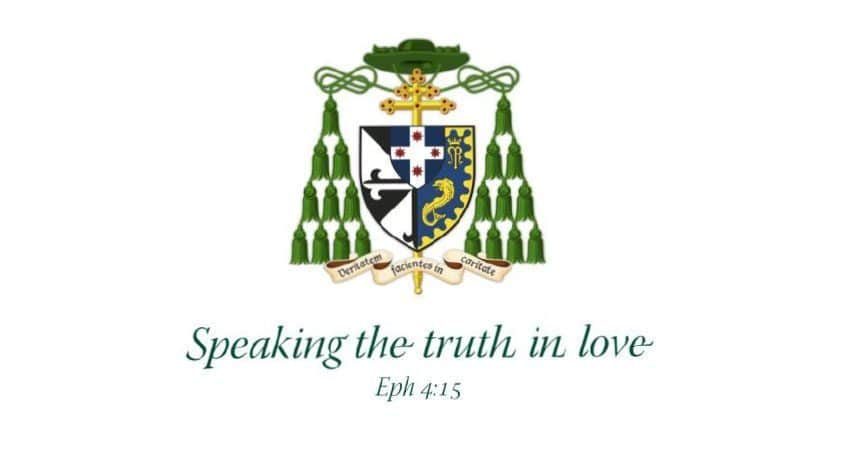HOMILY FOR THE MASS OF PALM SUNDAY OF THE PASSION OF THE LORD (YEAR B)

St Mary’s Cathedral, Sydney, 27 March 2021
Three years ago, when last we heard St Mark’s Passion (Mk chs 14 & 15), I observed that only he includes the flight of the stark-naked youth from the Garden (Mk 14:50-52). Light relief, I called it, in an unremittingly awful tale and, given Jewish attitudes to public nudity,[i] symbolic of unredeemed humanity, exposed and humiliated.
Yet the one most often naked in the Gospels – 8 or 9 times in fact – is Jesus Himself and each time it marks something very significant, even transformative. The story of redemption begins with God taking our flesh and so coming naked from His mother’s womb. A fleshy bambino in the iconographic tradition, He poses first for Italian painters before His parents wrap Him in swaddling clothes (Lk 2:7). The author of Life made Himself as vulnerable as a baby so we would not only have life but “life to the full” (cf. Jn 10:10).
On the eighth day the boy’s parents unwrapped Him so they might do for Him all that the Law required (Lk 2:21-24). The author of the Law made Himself subject to the Law that He might transform the Law from precepts into beatitudes.
A third time the Lord is unclothed, when He’s baptised by John (Mk 1:9-11 et par.). The sinless One is made sin for us, the second Adam repairs the naked shame of the first. The giver of Water is plunged into the waters to make a new sacrament, and so begin a whole new sacramental economy.
That water reminds us that on the night He was betrayed, Jesus “got up from the table, took off his outer robe, tied a towel around himself, poured water into a basin and began to wash the disciples’ feet” (Jn 13:1-20). Though not quite naked, He assumed the posture of a slave. The source of all Service makes Himself a servant to elucidate our discipleship as service.
He is soon undressed a fifth time. Arrested and condemned, Mark says He was then scourged (Mk 15:15 et par.; cf. Mk 14:65; Lk 23:16). The source of all Justice suffers grave injustice, so all victims might be promised vindication in the end.
Mark tells us the soldiers later stripped Jesus again, before dressing Him in a royal purple robe and crown of thorns to taunt Him. Then they disrobed Him again and put Him back in His own bloodied clothes (Mk 15:16-20 et par.). The source of all Authority is reduced to a mockery of a king, while converting our understanding of authority forever.
Crucifixion was a slow, excruciating death, but to add to its ignominy the Romans hung the victims naked. And so for an eighth time the Lord is exposed for all to see. Mark records that having crucified Jesus the soldiers made play even of His clothes (Mk 15:24).[ii] The Son of Man must suffer every indignity, carrying to Calvary the weight not just of the Cross but of every sin and distress. Only thus can the impassible God suffer pain and anguish; only then can He redeem these things from within and promise “You will be with me in Paradise” (Lk 23:43).
“Naked I came from my mother’s womb, naked I shall return” said Job, “The Lord gives, the Lord takes away: Blessed be the name of the Lord!” (Job 1:21; cf. Ecc 5:15). Jesus is stripped, not just of clothes, divine glory, human dignity, friends, but even (so it felt according to Mark) His Father-God (Mk 15:34). But by submitting to death, He transforms the despair of the grave into the Hope of life beyond.
Today’s Passion ended with Jesus being wrapped in a shroud and laid in a tomb. But there is one more chapter to His life story. Jesus will rise again, leaving behind His grave-clothes (Lk 24:12; Jn 20:5-7). Newly reborn, Jesus is still flesh and blood as at His birth, but now rather than swaddling “He is wrapped in splendour as in a robe” (Ps 104:1-2), transfigured with light.
There we have it: in the starkers youth who is humanity in all its need and in the nine-times-naked Jesus who is God supplying our every need. Christ transforms bare life into flourishing, law into beatitude, water into sacrament, discipleship into service, power into authority, injustice into vindication, suffering into promise, death into a door to eternal life. This coming week we’ll see how!
[i] Ever since God made clothes for Adam and Eve (Gen 3:21) the Jews had been modest, cover-up sort of people, not out of hatred for the body but out of reverence for it, not for fear of sexuality but realism about its power. Public nudity was associated with the lewdness of Greeks in their gymnasiums and of harlots in their brothels – and so the infidelities of Israel – or else with the desperation of slaves and the poor – and so the periodic humiliation the Jews received: Gen 3:7-11; 9:22-3; Dt 28:48; 2Sam 6:20; Job 22:6; 24:7,10; Isa 47:3; 57:8; Lam 1:8; 4:21; Ezek 16:22,36-9; 23:10,18,29; Isa ch 20:2-4; Jer 13:2-7; Hos 2:3,9; Amos 2:16; Mic 1:8-11; Nah 3:5; Hab 2:15-6; cf. 1Cor 12:22-24; 2Cor 5:3; Rev 3:18-8; 16:15; 17:16 etc. The naked youth seems to be in this line of sad and sorry persons, like the Gerasene man we meet earlier in the Gospels (Lk 8:26-39; cf. Mk 5:1-20; Mt 8:28-34) possessed by legion demons and long living without clothing or shelter.
[ii] Cf. Ps 21(22):18; Mt 27:35; Lk 23:34; Jn 19:23-25.
It’s been good to begin Holy Week with you and we give thanks that we are much freer this year to celebrate it than we were this time last year or than our brothers and sisters in many places. I invite you all to make the most of the gift of this week, making it a kind of retreat, especially by participating in the great liturgy of Maundy Thursday – Good Friday – Easter Night.

